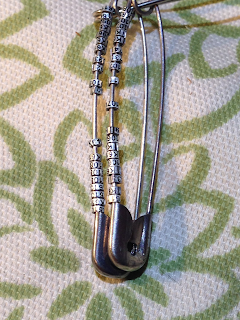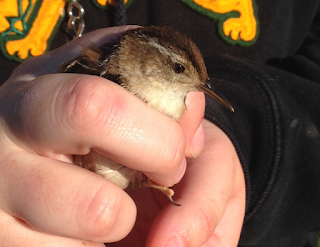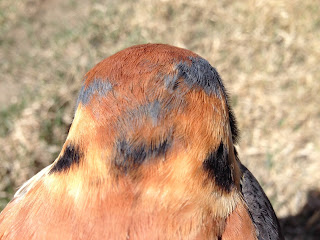I got a request to post a new update to the old blog, so here we are. I'm excited to share a new and old project with you here - banding Common Grackles!
From 2015-2020 I banded 319 grackles here at the farm, catching on average 53 new grackles each year and recapturing 18 banded grackles from previous years. Just this winter, using these data my friend Dr Ryan Fisher and I were able to calculate the annual survival rate of grackles at my farm. Our paper has been accepted for publication in the North American Bird Bander, so stay tuned for more about that.
But from these results more questions arose. Looking at our data, some birds are recaptured many years following their initial banding, while others are caught initially and then not recaptured for years! The longest time interval was a female grackle banded in May of 2012 and then not recaptured again until 2020! That bird was 9 years old when she was recaptured! Where was she from 2013 to 2019? Was she here in the yard, but just didn't get caught or was she nesting in another farmyard somewhere nearby?
So I decided coded colour bands are going to help answer some of these questions! And that's what I have been up to this spring. These highly visible bands will allow me to resight the grackles in our yard, even if they know how to avoid my trap. So far this spring, I have placed 51 colour bands onto both previously unbanded and recaptured grackles.
From 2015 to 2020 the birds were banded with a standard metal band. There are 9 numbers that wrap around the band and are difficult to read unless the bird is in your hand, hence the the need to actually recapture them. The colour bands on the other hand are all yellow with black coding and very easy to read with binoculars or a spotting scope. They have 2 letters that are large and repeated around the band. AB was the first band used (I accidently broke AA... haha) and continue through to AZ, then BA to BZ, etc.
With these coded bands, I am also locating nests in my yard and trying to determine specific nesting locations of individuals to see where they nest in the yard from year to year. I'm also hoping to see if some of these banded birds are observed in nearby farmyards or towns, perhaps even during migration. And I am also really hoping some of these bands will be read on their wintering grounds in the eastern United States to give us some exact locations for where Saskatchewan grackles spend their winter. However, there are an estimated 61 million Common Grackles in North America, so my 50-80 colour banded birds may be easily missed. I'm not getting my hopes up too high.
So if you have found this blog post because you have seen a yellow banded common grackle, please send me an email! clarkejared@hotmail.com.
What I love about this whole project, is getting to know the birds who nest in our yard. For example, 1573-01581 is a male grackle that I banded on April 21, 2017 and have recaptured each year following here in our yard (2018, 2019, 2020, and even 2021!). This male has come back to our yard for 5 years in a row. He now also wears a yellow band with code BF.
A female, 1352-42767, was banded on May 7, 2015, and has been recaptured in our yard in 2017, 2019, 2020 and again in 2021. She is at least 7 years old now (but could be older). She is now wearing band CB.






































